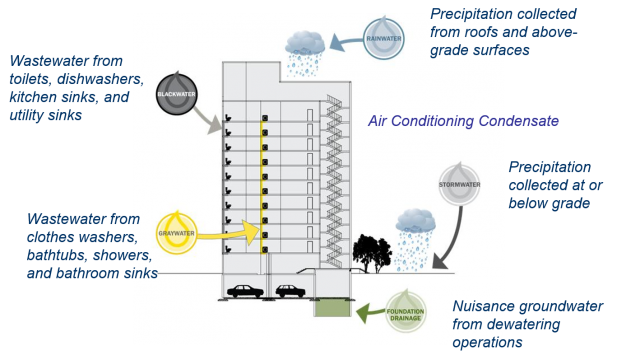Non-Potable Environmental and Economic Water Reuse (NEWR) Calculator
Identify Source Water Options for Non-Potable Reuse
The Non-Potable Environmental and Economic Water Reuse (NEWR) Calculator is a simple to use web-based tool for screening-level assessments of source water options for any urban building location across the United States that is considering onsite non-potable reuse.

Platform and Compatibility
NEWR is a single page web application that requires an internet connection and JavaScript enabled in the browser. The web-based application can be used on desktop devices and on mobile devices, such as smartphones and tablets. It is compatible using modern browsers with Windows and Mac operating systems.
Disclaimer: Any mention of trade names, manufacturers, or products does not imply an endorsement by EPA. EPA and its employees do not endorse commercial products, services, or enterprises.
Capabilities
Non-potable water reuse is one solution that can help communities reclaim, recycle, and then reuse water for non-drinking water purposes, such as toilet flushing, clothes washing, and irrigation.
NEWR can be used to identify the most environmentally and cost-effective suite of source water options to meet non-potable needs based on geography, climate, building size, and building type. Potential environmental impacts are estimated in NEWR using life cycle assessment following guidelines specified by the International Organization for Standardization (ISO 14040/44).
Life cycle assessment integrates environmental impacts occurring not only during operation of a water reclamation system, but throughout upstream supply-chains as resources are extracted, processed, distributed, and consumed. Benefits (or avoided impacts) from shifting away from reliance on centralized infrastructure to onsite non-potable water reuse are also incorporated in NEWR. In addition to estimating environmental indicators using life cycle assessment, the calculator generates life cycle cost assessment results, a similarly comprehensive approach to approximating economic costs over the lifetime of a system.
Applications

NEWR can be used by any building designer, utility personnel, or water resource professional looking to evaluate source water options for onsite non-potable reuse at a preliminary or screening level of detail. However, it is not intended to provide a detailed engineering assessment for onsite non-potable reuse systems. NEWR is recommended for users interested in screening level environmental and cost assessments of non-potable reuse systems for buildings with 50 or more occupants.
Related Resources
Research Publications:
- A unit process log reduction database for water reuse practitioners (2024). This review presents a database of compiled log reduction values (LRVs) and log reduction credits (LRCs) for unit processes capable of providing some level of pathogen reduction, with a focus on processes suitable for onsite non-potable water reuse systems.
- Onsite Non-potable Reuse for Large Buildings: Environmental and Economic Suitability as a Function of Building Characteristics and Location (2021). This study describes and utilizes NEWR to explore the potential of four source waters for a variety of building configurations throughout the United States. Results describe prominent geographic trends and comparative results between source waters.
- Human Health, Economic and Environmental Assessment of Onsite Non-Potable Water Reuse Systems for a Large, Mixed-Use Urban Building (2020). This study used quantitative microbial risk assessment, life cycle assessment, and life cycle cost analysis to characterize the human health, environmental, and economic aspects of onsite non-potable water reuse systems. The use of multiple metrics allows for identification of weaknesses in systems that lead to burden shifting and provides balanced decision making.
- Life Cycle Assessment of a Rainwater Harvesting System Compared with an AC Condensate Harvesting System (2019). This study presents a comparative life cycle assessment of nine scenarios of separate and combined rainwater harvesting and air-conditioning condensate harvesting systems in a 4-story building in Washington, D.C. and in 4-story and 19-story buildings in San Francisco, CA. Eleven life cycle impact assessment categories were addressed.
- Life Cycle Assessment and Cost Analysis of Distributed Mixed Wastewater and Graywater Treatment for Water Recycling in the Context of an Urban Case Study (EPA/600/R-18/280, 2019). This study used life cycle assessment and life cycle cost assessment to evaluate several urban building and district scale treatment technologies based on a suite of environmental and cost indicators. The project evaluated aerobic membrane bioreactors, anaerobic membrane bioreactors, and recirculating vertical flow wetlands treating both mixed wastewater and source separated graywater.
Science Matters Stories:
Related Research:
Technical Support
Questions or comments about NEWR: Contact Cissy Ma at [email protected].
